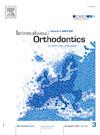Quality of occlusal outcome in adult patients with posterior crossbite treated with completely customized lingual appliances and CAD/CAM archwires for maxillary expansion and mandibular compression compared to adult Class I patients: A retrospective study
IF 1.9
Q2 DENTISTRY, ORAL SURGERY & MEDICINE
引用次数: 0
Abstract
Purpose
There is a lack of evidence regarding whether non-surgical crossbite correction leads to compromised occlusal outcomes. The aim of this study was to objectively evaluate the quality of the occlusal outcome and the transverse correction after non-surgical crossbite correction in adults compared to adult patients with no pretreatment crossbite.
Material and methods
This retrospective study included 80 adult patients treated consecutively with completely customized lingual appliances (CCLAs) between 2019 and 2021. Crossbite correction was performed with CAD/CAM expansion archwires in the maxilla and compression archwires in the mandible. Occlusal outcome was evaluated using the American Board of Orthodontics (ABO) Model Grading System (MGS), and transverse metric measurements were performed, both on plaster models before treatment (T1), on the set-up models (T2A) and after debonding (T2B).
Results
From a total of 1098 patients debonded during the observation period, 40 patients (f/m 30/10, mean age 33.6 ± 10.9 years) with unilateral or bilateral crossbite were enrolled in the crossbite group. The matched non-crossbite control group consisted of 40 Class I patients (f/m 30/10, mean age 30.7 ± 9.1 years). No statistically significant difference was observed between the crossbite and non-crossbite groups regarding the total ABO score at T2B (20.7 vs. 18.8, p > 0.05), despite the malocclusion being significantly more severe in the crossbite group at T1 (68.1 vs. 41.0, p < 0.001). In both groups, 38 out of 40 patients (95%) would have passed the ABO examination (total score at T2B ≤ 25). All crossbites were completely corrected at T2B, with a mean total transverse correction of 6.7 ± 2.3 mm (3.2 ± 2.1 mm maxillary expansion, 3.5 ± 2.4 mm mandibular compression).
Conclusion
Non-surgical crossbite correction did not lead to compromised occlusal results. CCLAs in combination with CAD/CAM expansion and compression archwires can correct posterior crossbites successfully in adult patients. The final occlusal outcome can be of a similar high quality in crossbite and non-crossbite patients.
采用完全定制的舌器和CAD/CAM弓线进行上颌扩张和下颌骨压缩的成人后牙合患者的咬合结果质量与成人I类患者的比较:一项回顾性研究
目的:关于非手术矫正是否会影响咬合效果,目前还缺乏证据。本研究的目的是客观评价成人非手术矫正后的咬合结果和横向矫正的质量,并与未进行预处理的成人患者进行比较。材料和方法本回顾性研究纳入了2019年至2021年间连续使用完全定制化舌器(CCLAs)治疗的80例成年患者。在上颌使用CAD/CAM扩展弓丝,下颌骨使用压缩弓丝进行十字咬合矫正。使用美国正畸委员会(ABO)模型分级系统(MGS)评估咬合结果,并在治疗前(T1),建立模型(T2A)和脱粘后(T2B)对石膏模型进行横向度量测量。结果观察期内共1098例脱粘患者,其中单侧或双侧交叉牙合患者40例(f/m 30/10,平均年龄33.6±10.9岁)入组。匹配的非十字咬合对照组为I类患者40例(f/m 30/10,平均年龄30.7±9.1岁)。在T2B时,咬合组与非咬合组的ABO总评分差异无统计学意义(20.7比18.8,p >;0.05),尽管T1时交叉咬合组的错牙合更严重(68.1 vs. 41.0, p <;0.001)。两组40例患者中有38例(95%)通过ABO检查(T2B总分≤25)。所有的咬合在T2B完全矫正,平均总横向矫正6.7±2.3 mm(上颌扩张3.2±2.1 mm,下颌骨压迫3.5±2.4 mm)。结论非手术矫正不影响牙合效果。CCLAs联合CAD/CAM扩展和压缩弓丝可以成功矫正成人患者的后牙合。最终的咬合结果在交叉咬合和非交叉咬合患者中可以达到相似的高质量。
本文章由计算机程序翻译,如有差异,请以英文原文为准。
求助全文
约1分钟内获得全文
求助全文
来源期刊

International Orthodontics
DENTISTRY, ORAL SURGERY & MEDICINE-
CiteScore
2.50
自引率
13.30%
发文量
71
审稿时长
26 days
期刊介绍:
Une revue de référence dans le domaine de orthodontie et des disciplines frontières Your reference in dentofacial orthopedics International Orthodontics adresse aux orthodontistes, aux dentistes, aux stomatologistes, aux chirurgiens maxillo-faciaux et aux plasticiens de la face, ainsi quà leurs assistant(e)s. International Orthodontics is addressed to orthodontists, dentists, stomatologists, maxillofacial surgeons and facial plastic surgeons, as well as their assistants.
 求助内容:
求助内容: 应助结果提醒方式:
应助结果提醒方式:


